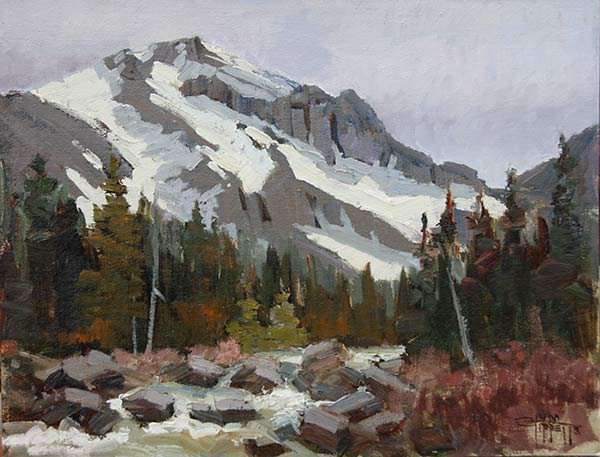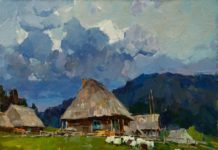Linda Tippetts is more than just a notable artist, and she’s more than just a distinguished woman artist, although her strides in that regard are worth noting. Tippetts is one of the key figures in this era’s pantheon of plein air painters, having slugged it out on location since the 1960s. And she will be sharing her knowledge and wisdom at the 2016 Plein Air Convention & Expo (PACE) this April in Tucson, Arizona.
Tippetts does work in the studio, but she says, “My first love is painting outside. It’s a constant juggling act between reaction, and thinking or will. I’m always trying to balance that. Painting on location really develops that reaction ability. That’s when the magic comes — but it also produces a lot of Frisbees.”
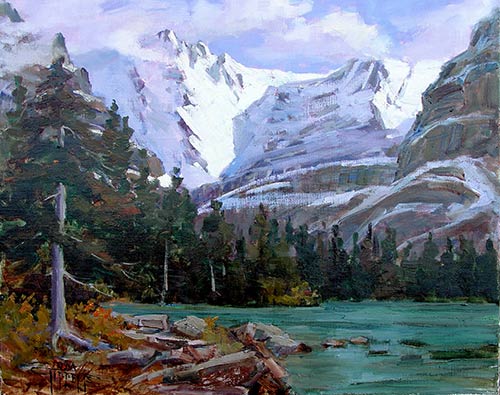
“Lake O’Hara,” by Linda Tippetts, oil, 14 x 18 in.
The Montana artist says one of her key tenets is to paint the adjective, not the noun. In other words, “When painting, you will hit closer to the mark if you reach for the cold instead of the snow, the shocking red instead of the poppies, or the majesty instead of the mountain. Find one word that applies when beginning each painting. Is that word strength, harmony, power, peace, excitement, or mystery? Or simply a tribute to the nature of that figure or that structure? In other words, paint adjectives, or that which describes a subject, to avoid literal translations. Ask what emotion arises when you begin a painting.”
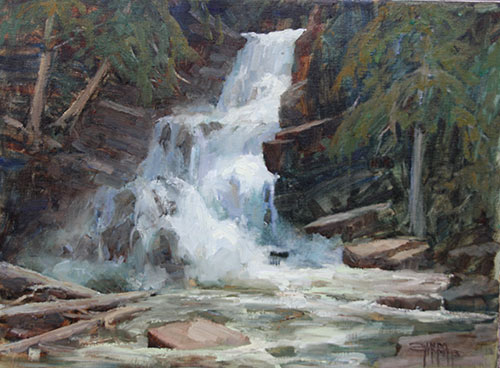
“Double Falls — High Water,” by Linda Tippetts, oil, 18 x 24 in.
Tippetts grew up on a ranch in Montana, and didn’t get bitten by the art bug until she was in her 20s, when she witnessed the first C.M. Russell auction and show in Great Falls, Montana, in 1969. “I was driving a tractor and the trucks and feeding cows when some were taking ballet lessons,” she says. “The work ethic has shaped me, as well as the relationship to the land. When you are digging in your own dirt and that’s how you make your living, you forge a relationship with the land. That relationship started in childhood.”
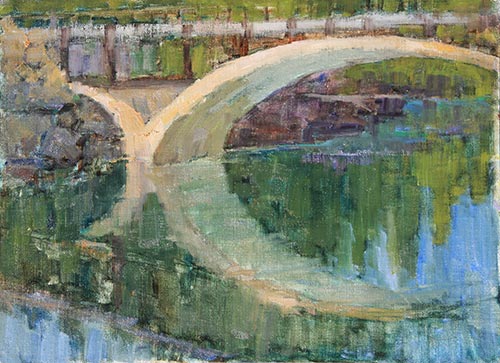
“Belton Bridge Design (Bridge to Infinity),” by Linda Tippetts, oil, 11 x 14 in.
Tippetts still hikes the mountains, finding inspiration and keeping close to the land. “One of the big reasons I hike in the mountains a lot is that I want to see what’s over the next ridge,” she says. “I have a lot better luck not having preconceived notions when I hike. I like to be open to what hits me at the moment. If I have a preconceived notion, I miss what’s really there. It’s the same with a painting. I try to stay with my first impression. I don’t do thumbnail sketches — if I do that, I lose my initial excitement. I take transparent paints and move them around and make value sketches right on the canvas until it feels good. You have all those rules, but sometimes I can’t remember all the rules and have to go by what I find pleasing. I end up with that map on my canvas, which holds me beyond that original ‘aha’ moment. I find it works if I go into it making a lot of starts.”
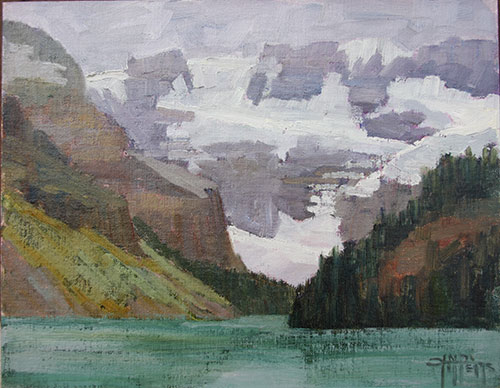
“Lake Louise,” by Linda Tippetts, oil, 11 x 14 in.
In fact, Tippetts says she strongly believes that the start is the main thing, and as the painting is approaching completion, it becomes the artist’s job to listen to what the painting needs. “After many years and hundreds of starts, now the painting will finish itself,” she avers. “Listen to your painting when you get into the red zone.”
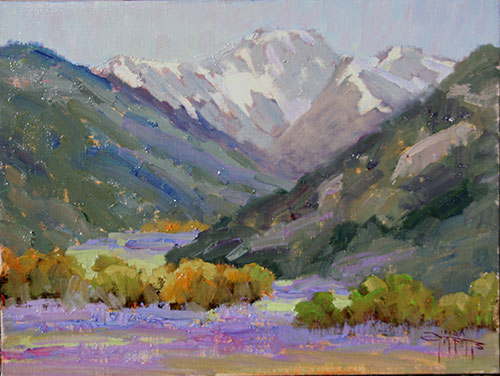
“Colorado Larkspur,” by Linda Tippetts, oil, 12 x 16 in.
The artist is looking forward to participating in PACE; she will be a field painter and will also be on a panel for a discussion moderated by Jean Stern. You can bet that the subject of women painters will come up. Tippetts walks the line between wanting to discuss the ongoing disparity in the fine art world — with men more heavily represented in gallery and museum shows and in high-profile competitions — and standing on her own merits with a blind eye turned toward her gender. “I am a woman artist who happens to be female,” says Tippetts. “But I’m sure that part of the topic will be celebrating the women artists who have gone before who never received the recognition. They were very good, but didn’t receive their due.”
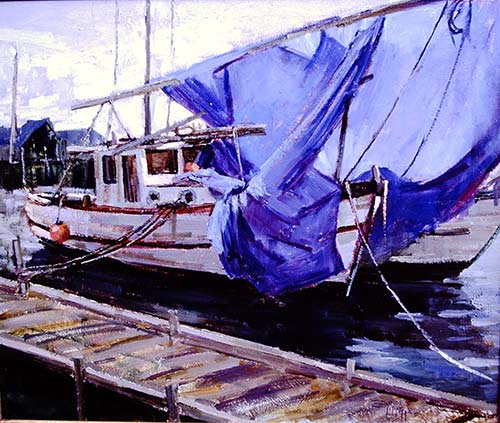
“Blue Tarp,” by Linda Tippetts, oil, 12 x 16 in.
Tippetts was one of four contemporary artists featured in a show at the Hockaday Museum of Art in Kalispell, Montana, this past summer. Titled “A Timeless Legacy — Women Artists of Glacier National Park,” the exhibition showed that women artists have been depicting the rugged beauty of that park for nearly a hundred years, and without the funding or acclaim enjoyed by their male counterparts, regardless of the quality of their work. Carole Cooke, Kathryn Stats, and Rachel Warner were the other three contemporary painters showcased in the show, which ran May 28 through July 25, 2015.
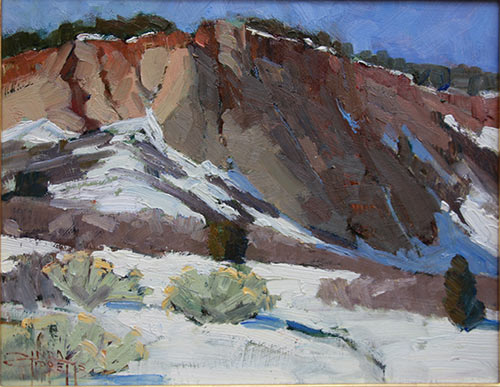
“Cliffs of Zion,” by Linda Tippetts, oil, 11 x 14 in.
Tippetts is excited that public television stations in Montana will be rebroadcasting a documentary film about the legacy of women artists in Glacier throughout the coming year. She says, “I came away from that show seeing the dedication and hardship those early artists endured, while their male counterparts were funded by the railroad and received the accolades. Dedication has no gender. Those early women artists paved the way, and now I am able to follow in their footsteps. But we don’t want to dwell on this. We just want to be good at what we do.”
She has put in the time and effort over the years to become a top-flight plein air painter, one of the pioneers of the modern plein air movement. Tippetts was one of the participants at the first Plein-Air Painters of America show on Catalina Island in 1986 — arguably the first wet-paint event and sale of plein air paintings in this era. She is still organizing painting trips and criss-crossing the backcountry, finding her inspiration and committing it to canvas. She wants to express an emotion, and she likes seeing that in other people’s work. “It’s a juggling act between how I feel and what I know,” says Tippetts. “When I see an artist lean a little bit more to how they felt rather than what they know, I like it. There’s a certain charm in seeing who that person is. They went beyond the rules, went into the zone, and went with it.”
To find out more about the Plein Air Convention & Expo (PACE) and to register for the April event, go here.

